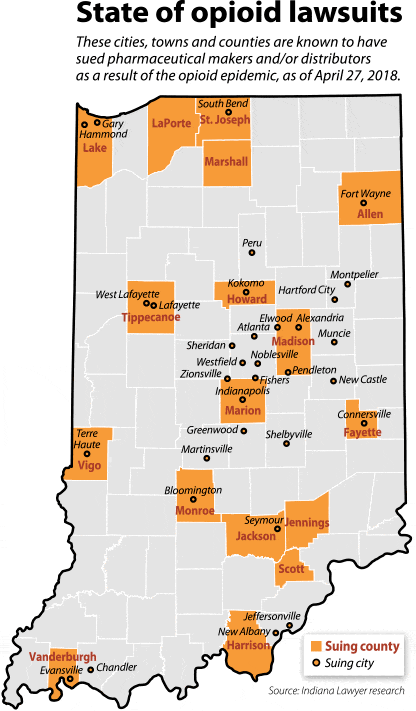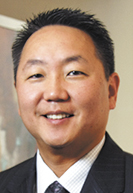Subscriber Benefit
As a subscriber you can listen to articles at work, in the car, or while you work out. Subscribe NowBob Houston, attorney for Scott County, can rattle off the financial impact the opioid and heroin epidemic has had on his community.
The health department and jail have needed more money to treat and house the high number of addicts. Meanwhile, property values have declined as families decide not to buy a home in the troubled southern Indiana county and companies look elsewhere to open a business.
 Indeed, the need has become so great that Houston mused if he was given several million dollars to spend on the community, he wouldn’t know where to put the first dollar.
Indeed, the need has become so great that Houston mused if he was given several million dollars to spend on the community, he wouldn’t know where to put the first dollar.
“I don’t know how to compare this to anything else we’ve seen,” he said.
To get some relief, Scott County filed a lawsuit against opioid manufacturers and distributors in September 2017, making it among the first — if not the first — locality in Indiana to take such action. Since then, multiple Indiana towns, cities and counties have filed their own complaints, and plaintiffs’ attorneys say more are coming.
The Hoosier lawsuits have been consolidated with the opioid complaints filed by other municipalities across the country into a multi-district litigation. With about 500 separate lawsuits, the MDL has been placed in the U.S. District Court for the Northern District of Ohio in Cleveland, in the courtroom of Judge Dan Polster.
According to the New York Times, Polster told the lawyers at the first hearing in January to start working on settlement discussions. He has set an aggressive timetable for amending complaints and filing motions to dismiss. Also, he scheduled three bellwether trials to start simultaneously on March 18, 2019.
As he indicated at that first hearing, the MDL must move quickly because people are dying every day from overdoses.
Reports from the Centers for Disease Control and Prevention found opioid prescriptions in the United States nearly quadrupled since 1999, and by 2016, the number of opioid prescriptions written was roughly equal to the number of adults in America. Meanwhile, overdose deaths rose to approximately 64,000 people in 2016, a 22 percent increase from the year before.
Legal action, Houston said, “may be one of the best alternatives.” The defendants sent the drugs to Scott County and the community has suffered financially as a result. “It does not seem to me we have another alternative.”
Financial burden
Scott County became the national face of the crisis when uncontrolled opioid use was compounded by an HIV outbreak caused by the sharing of dirty needles to inject drugs.
Even so, when Houston started calling law firms in Indianapolis and Louisville, Kentucky, to ask about the possibility of civil legal action, he got little interest. Some offered to research the issue for a fee, but Houston did not want to add another expense to his community’s budget.
Houston was able to find someone willing to do more than listen. A lawyer from Squire Patton Boggs, who happened to own a farm in Scott County, pointed the county attorney to Louisiana attorney Frank Dudenhefer Jr. Although the New Orleans lawyer initially filed in state court, the case has been rolled into the MDL.
The motivation behind the lawsuits is the money the communities have spent and will continue to spend fighting drug abuse. Attorneys from Cohen & Malad LLP and Taft Stettinius & Hollister LLP, who are representing numerous municipalities across the state, said cities and counties are struggling. Expenses have risen for first responders, jails, coroner offices and courts even as resources dwindled due to lost productivity and declining tax revenue.
 Toops
ToopsA remedy for the crisis, attorneys said, will likely include damages for the expenses already incurred and a forward-looking abatement to cover future education and treatment costs. Also, an injunction to change the defendants’ business practices will probably be a part of any settlement.
“We have an entire population, their brains are altered by addiction for the rest of their lives,” said Cohen & Malad partner Lynn Toops. “An entire generation has almost been lost to this epidemic.”
Defense attorneys contacted for this story provided no comment.
Some attorneys general have filed similar lawsuits on behalf of their states. Indiana Attorney General Curtis Hill’s office, which has hired Washington, D.C.-based Cohen Milstein Sellers & Toll PLLC to investigate the issue, said it is working diligently on the matter but declined to discuss what factors are being considered in deciding whether to file a complaint.
 Lee
LeeThe state has been impacted differently than the local communities, so if Indiana does move forward with its own litigation, that will not hinder other plaintiffs, attorneys said. Any settlement or jury award will still flow to the local municipalities for them to determine how to use.
“There’s not going to be a magic bullet that’s going to cure it,” said Taft partner Chou-il Lee. “Each local community is going to have to work with its neighbors and its counties to come up with a program that best suits their needs.”
Collaborating for profit
The crisis and costs are caused not just by opioid pain pills, but also by the rise in heroin use. Plaintiffs’ attorneys assert they are one in the same.
In the complaints, the cities and counties detail a concerted effort by the manufacturers and distributors to change the thinking about opioid medication. The defendants allegedly infiltrated the medical profession, convincing physicians and the public that opioids are safe for long-term chronic pain.
Toops said the actions of the defendants take corporate misbehavior to a whole new level. “Taking a drug that’s been around forever and getting it to basically kill a generation of people is just unbelievable,” she said.
Opioids, classified as schedule II drugs because of the risk of physical and psychological dependence, are regulated under the Controlled Substances Act of 1970. The CSA limited the production of opioids to a quota set by the Drug Enforcement Agency and gave a duty to the makers and distributors to monitor, investigate, report and stop suspicious orders.
Plaintiffs’ attorneys said the pharmaceutical businesses did none of that. Instead, they worked together through the Opioid Diversion Enterprise to increase sales and boost revenue into the billions. That alleged collaboration forms the basis of the plaintiffs’ claim under the Racketeer Influenced and Corrupt Organizations (RICO) Act.
 Herceg
HercegThe defendants, according to the plaintiffs, did not tell federal agencies about suspect orders and, in fact, paid rebates to incentivize unlawful opioid prescription sales in addition to targeting areas where the pills were selling in large volumes. Moreover, they pushed the DEA to increase the quota while they lobbied Congress to weaken the agency’s enforcement authority.
Taft associate Manny Herceg said cities and counties believe the companies shirked their responsibility and flooded the market with opioids. Individuals became addicted, so when they could not get as many pills or were unable to afford their prescription, they began using heroin to avoid withdrawal symptoms.
“They created a full-blown black market because of the uncontrolled flow of opioids into our communities,” Herceg said.
 Tidmarsh
TidmarshNotre Dame Law School professor Jay Tidmarsh, an expert in complex civil litigation, said the plaintiffs will have a difficult task making the causation argument. Juries, which tend to be especially skeptical in product liability cases, may look upon the addicts as being responsible for their own circumstances, having made a conscious choice to abuse heroin.
Defendants, he said, could take a page from the tobacco litigation playbook. They could argue the individuals made a lifestyle choice when they began abusing the narcotics. Still, the risk for the manufacturers and distributors is that when juries do side with the plaintiff, they tend to award higher damages.
Tidmarsh said the benefit of the litigation will be to keep the attention on the opioid crisis and create pressure for the two sides to craft a solution. Like Houston, the law professor conceded filing a lawsuit to address the epidemic might not be the best option, but the alternatives are not any better.
“Is there another way?” Tidmarsh asked. “I’m not sure there is.”•
Please enable JavaScript to view this content.
